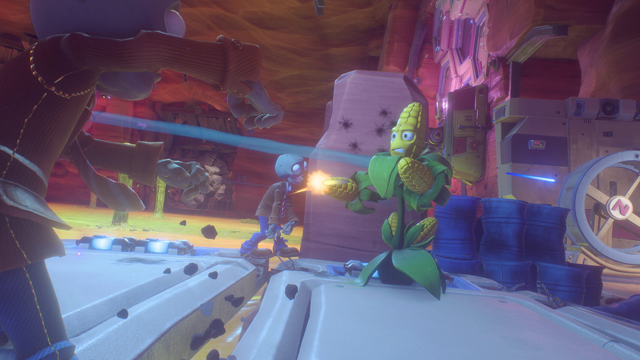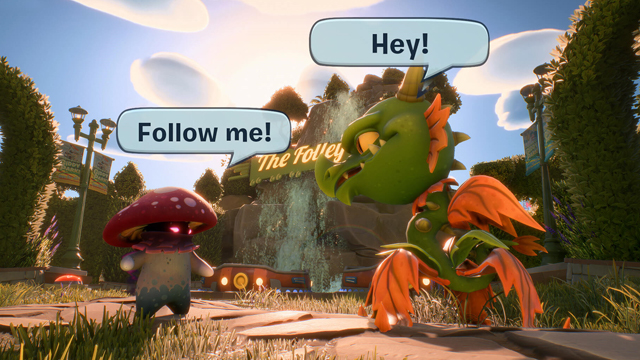Plants vs Zombies: Garden Warfare is an underrated series. So underrated, in fact, that publisher EA and developer PopCap Games has decided to drop that subtitle altogether. Now we’re introduced to Plants vs Zombies: Battle for Neighborville, a new third-person PvE and PvP shooter, which is Garden Warfare 3 in all but name. But while the greenery may still be locked in an eternal war with the undead, Battle for Neighborville is a more competitive offering than its predecessors. Unfortunately, this replaces a lot of what made the previous two games so entertaining.
Battle for Neighborville initially appears to be more of the same, only bigger. Its new social hub, Giddy Park, feels less barren than Garden Warfare 2‘s Backyard Battleground, centering around a fairground complete with a Ferris Wheel and a carousel. There are three additional free roam regions — Neighborville Town Center, Weirding Woods, and Mount Steep — in which you can complete story-based quests alongside up to three friends. Then there are your cosmetic booths, allowing you to customize each of the game’s 20 unique characters, and the multiplayer portal which allows you to dive into matchmaking.
ALSO: Preview | The Souls is strong with Star Wars Jedi: Fallen Order
Multiplayer modes such as Team Vanquish and the objective-based Turf Takeover return, along with Garden and Graveyard Ops. The new Battle Arena pits two teams of 4 against one another in the ‘Funderdome,’ with characters being locked out of each round. There’s also Mixed Ops, which offers more eccentric game types such as Gnome Bomb and Suburbination, and a rotating match type that is currently changed every week.
Plants vs Zombies: Battle for Neighborville Review | Not even headshots work on these zombies

It all seems like a suitable extension of the Garden Warfare formula, until you get into a match and realize that some extensive tinkering has taken place under the hood. Garden Warfare was attractive because it provided a more casual spin on the class-based shooter; to me, the series was the modern equivalent of 2005’s Conker: Live & Reloaded. It didn’t take itself seriously and wanted to entertain rather than throw churn out yet another competitive shooter. However, Battle for Neighborville features some odd changes that make it oddly inaccessible.
The first major change is its increased time-to-kill. While opponents in the previous PvZ: Garden Warfare games were relatively spongey, vanquishes (the series’ term for kills) are particularly hard to come by this time around. You can spend a lengthy amount of time shooting at a rival, only for them to hurriedly disappear behind cover. Few characters have weapons with satisfying weight to them, with many feeling as though they’re carrying out chip damage. As a result, PvP has a much higher difficulty curve than you’d expect from a game that should appeal to a younger audience.
Balancing issues are also present, mostly with the new characters that PopCap Games has introduced. Night Cap, a stealthy mushroom ninja with high mobility, is a pain to deal with thanks to her lack of a natural counter. Snapdragon also doesn’t have to worry about the frustratingly small hitboxes with his fire breath primary attack, overlooking the high level of accuracy required by every other character.
Plants vs Zombies: Battle for Neighborville Review | Bye-bye variants

These aiming issues are exacerbated by Battle for Neighborville allowing each character to sprint. In previous Garden Warfare games, increased speed was locked behind certain abilities, but now each character can break out into a run. Combined with the higher time-to-kill and the small hitboxes, this makes the act of actually hitting things much more arduous than it ever has been. In particular, this harms the basic characters such as the zombie Foot Soldier, who in previous games has served as an entry point for new players due to his accessibility. However, with rivals now being much lighter on their feet, characters with lower damage output struggle greatly.
Although balancing is always tricky in shooters at launch, Battle for Neighborville has been publicly available via its Founder’s Edition for six weeks. This allowed PopCap to tinker with the game on live servers, and while changes have been rolled out in this time, multiple issues are still present in its “proper” launch. Stuttering is a regular occurrence, with frames dropping during movement. Playing on PC, I’ve frequently been dropped into matches with near-empty lobbies, with its Team Vanquish mode rarely having full teams from the get-go. Then there’s its progression system, which used to be one of Garden Warfare‘s main draws, but has now been neutered beyond recognition.
It’s understandable why PopCap Games wanted to move away from Garden Warfare‘s variants and sticker packs. In previous entries in the series, variants essentially offered classes within classes, allowing you to play as variations on a certain character that changed up their abilities. While this presented balancing issues, it also helped separate Garden Warfare from the pack. In a time when microtransactions face more scrutiny than ever before, having overpowered variants stored in randomized loot boxes — previous GW games used ‘sticker packs’ — would have likely been called into question. Battle for Neighborville does away with them altogether, replacing them with cosmetic-only capsules and a mundane upgrade system.
Plants vs Zombies: Battle for Neighborville Review | Making no progress

These capsules cost 30,000 coins apiece, which can be earned relatively quickly in PvE but are a slog to obtain in PvP. These capsules contain randomized cosmetic items, so sometimes you can unlock a rare snazzy hat, while other times you’ll pull out a broken sandal. In terms of gameplay-affecting progression, each character has up to seven upgrade points they can equip which offer different skills. For instance, one upgrade will allow for increased XP gain, while another will allow you to regain health after vanquishes. Leveling up your character will allow you to gain more upgrades, equipping characters with new skills.
While variants may be gone, this upgrade system does allow for a reasonable amount of customization in terms of adapting characters to match your playstyle. Though it may not be as exciting as variants, it can considerably change up how you approach certain characters. If this were complemented by a more exciting method of distributing cosmetics, it’d be serviceable, but as it stands there’s no real pull to convince players to keep investing their time. Battle for Neighborville would’ve benefited from retaining its sticker packs but keeping them cosmetic-only. Instead, players are offered a pitiful amount of cosmetic items for their coins.
Its PvE fares better. With multiple quests taking place across its maps, there’s a lot to do here whether you’re playing solo or alongside friends. Plants vs Zombies has a weirdly impenetrable lore at this point, with various oddly named NPCs offering you quests to complete in exchange for coins and items. You’ll fight vampire zombies, you’ll escort a lawnmower to a location, you’ll be tasked with finding a hat for a corn cob. It’s suitably nonsensical stuff, and is charming in its own right, even if there’s no point in trying to make sense of what story it’s trying to tell.
It’s also a joy to look at, retaining its colorful art style and over-the-top animations, while PopCap has gone all-out when it comes to the design of its new characters. Acorn — a small nut that transforms into a giant oak — is an incredibly unique class, allowing other Acorns to sit atop it like some roaming war machine. On the zombie team, Space Cadet is able to transform into a satellite that other Space Cadets can link to, creating a shuttle that deals out damage from all angles. These are classes that you just wouldn’t find in other class-based shooters.
Plants vs Zombies: Battle for Neighborville Review | The Final Verdict
Unfortunately, aside from its more robust PvE offering and unique new characters, most of the other changes that have been made in Plants vs Zombies: Battle for Neighborville haven’t been for the better. A lot of tweaks have served to make it far less accessible, while technical problems at launch — even after its extensive Founder’s Edition period — add frustration on top of its uneven difficulty curve. Battle for Neighborville seems targeted towards an audience that arguably doesn’t exist in any meaningful capacity — PvZ players who wanted a more competitive shooter with fewer customization options.
Plants vs Zombies: Battle for Neighborville reviewed on PC. Code provided by publisher.
-
Unique new characters like the Acorn and Space Cadet.
-
Gorgeous visuals and animations.
-
PvE is a solid, laid-back experience.
-
Difficulty curve is way too high for a casual, kid-friendly series.
-
Frustratingly high time-to-kill.
-
Routinely half-filled lobbies on PC.
-
Frame-rate stuttering is a routine problem.











